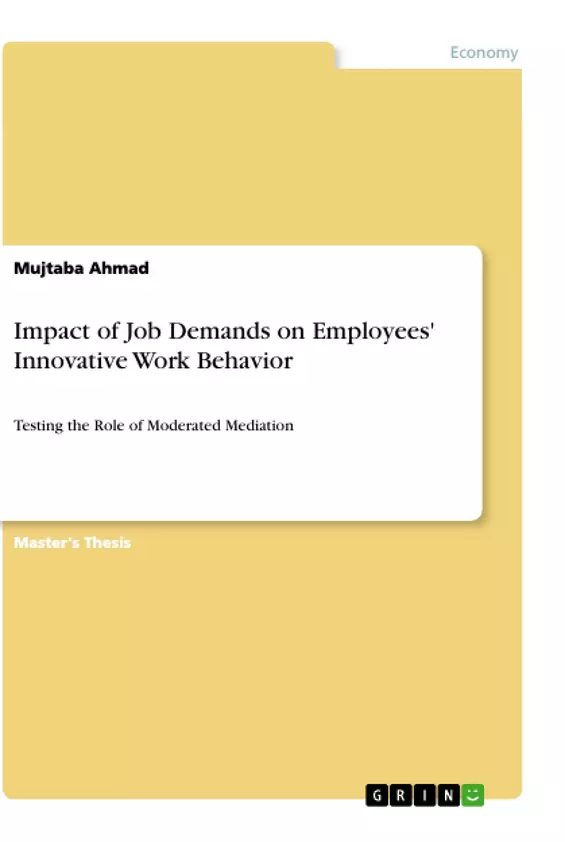The key significance of the current study is the investigation of the impact of job demands, job stress and positive affections in relationship with innovative work behavior of employees.
Studies in the past have mostly focused on the negative consequences of job stress on employees' innovative work behavior i.e. how job demands and job stress result in lower behavioral performances and job outcomes. However, this relationship may also be affirmative as employees may innovate in order to handle job stress resulting from the existence of high level job demands.
Innovative work behavior is a construct related to competitive advantage, economic development and success at organizational level, advancement in technology has compelled organizations to be innovative and embrace the change. Organizations are increasing job demands on employees to make them fabricate and execute novel ideas.
Inhaltsverzeichnis (Table of Contents)
- Chapter 1: Introduction
- Background
- Problem Statement
- Non-Governmental Organizations: Context of Problem Statement
- Present Study.....
- Research Questions.
- Significance of Study
- Rationale of the Study..
- Aim and Objectives of the Study
- Definition of Study Variables.
- Job Demands ….....
- Innovative Work Behavior.....
- Job Stress
- Positive Affections.......
- Chapter 2: Review of Related Literature........
- Innovative Work Behavior.
- Job Demands
- Job Stress....
- Positive Affections.
- Proposed Model....
- Hypotheses....
- Job Demands and Innovative Work Behavior
- Job Demands and Job Stress .......
- Job Stress and Innovative Work Behavior...........
- Job Stress as Mediator of Impact of Job Demands on Innovative Work Behavior..........
- Positive Affections and Innovative Work Behavior.......
- Positive Affections as Moderator of Relationship of Job demands and Innovative Work Behavior.....
- Chapter 3: Research Methodology......
- Research Approach and Justification of chosen Approach.
- Study Area........
- Selection of Non-Governmental Organizations......
- Target Population and Sampling Procedure
- Data Collection Methods
- Questionnaire ..
- Mode of Questionnaire Development..
- Structure of the Questionnaire
- Pilot study.
- Administration of the Questionnaire...
- Research Design.........
- Universe.
- Sampling.
- Procedure .....
- Instrumentation
- Measures
- Control Variables.
- Data Screening and Cleaning ....
- Reliability.………………….
- Convergent Validity.....
- Chapter 4: Results.
- Demographic Characteristics
- Test of Normality
- Descriptive Analysis of Dependent variable..
- Innovative work behavior.
- Descriptive Analysis of Independent Variables
- Job Demands......
- Job Stress ........
- Positive Affections..
- Divergent validity...
- Regression Analysis.
- Hypothesis-1(JDs and IWB).
- Hypothesis-2 (JDs and JS)..\li>
- Hypothesis-3 (JS and IWB)..\li>
- Mediating Impact of Job Stress....
- Impact of Positive Affections on Innovative work behavior
- Moderating Impact of Positive Affections
- Hypothesis-4 (JS Mediates the relationship between JDs and IWB).
- Hypothesis-5 (PAs and IWB)
- Hypothesis-6 (PAs Moderate the association between JDs and IWB).
- Chapter 5: Discussion......
- Job Demands effect on employee Innovative work behavior .
- Impact of Job Demands on Job Stress
- Impact of Job Stress on employee Innovative work behavior.
- Significance of the Study
- Limitations and Future Research...
Zielsetzung und Themenschwerpunkte (Objectives and Key Themes)
This study aims to investigate the impact of job demands, job stress, and positive affections on employee innovative work behavior in non-governmental organizations. Specifically, it examines the mediating effect of job stress on the relationship between job demands and innovative work behavior, and the moderating effect of positive affections on the relationship between job demands and innovative work behavior.
- The impact of job demands on employee innovative work behavior
- The role of job stress as a mediator in the relationship between job demands and innovative work behavior
- The role of positive affections as a moderator in the relationship between job demands and innovative work behavior
- The influence of job demands and job stress on employee innovative work behavior in non-governmental organizations
- The contribution of positive affections to employee innovative work behavior in non-governmental organizations
Zusammenfassung der Kapitel (Chapter Summaries)
Chapter 1 introduces the research topic, outlining the increasing demand for innovative work behavior and the associated challenges of job stress. It defines key study variables, including job demands, innovative work behavior, job stress, and positive affections. Chapter 2 reviews existing literature related to these concepts, exploring their relationships and presenting a proposed model and hypotheses. Chapter 3 details the research methodology, including the research approach, study area, target population, sampling procedure, data collection methods, and data analysis techniques. Chapter 4 presents the results of the study, including descriptive analyses of the variables and regression analyses to test the proposed hypotheses. Chapter 5 discusses the findings, drawing conclusions about the impact of job demands, job stress, and positive affections on employee innovative work behavior in non-governmental organizations.
Schlüsselwörter (Keywords)
The study focuses on the keywords innovative work behavior, job demands, job stress, positive affections, non-governmental organizations, mediating effect, moderating effect, employee performance, organizational context.
- Quote paper
- Mujtaba Ahmad (Author), 2015, Impact of Job Demands on Employees' Innovative Work Behavior, Munich, GRIN Verlag, https://www.grin.com/document/506029



